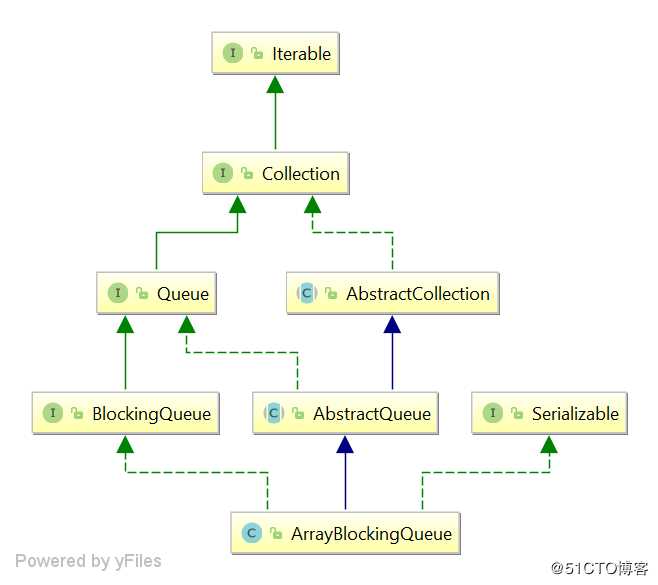标签:引用 影响 有一个 初始化 等于 ret 中断 一个 element
[TOC]ArrayBlockingQueue 是一个用数组实现的有界队列;此队列按照先进先出(FIFO)的规则对元素进行排序;默认情况下不保证线程公平的访问队列,所谓公平访问队列是指阻塞的线程,可以按照阻塞的先后顺序的访问队列,即先阻塞的线程先访问队列;非公平性是对先等待的线程是非公平的,当队列可用时,阻塞的线程都可以争夺访问队列的资格,有可能先阻塞的线程最后才访问;为了保证公平性,通常会降低吞吐量。

/** The queued items */
// 记录数据的数组
final Object[] items;
/** items index for next take, poll, peek or remove */
// 索引用于 take,poll,peek,remove 等方法
int takeIndex;
/** items index for next put, offer, or add */
// 索引用于 put,offer,or add 等方法
int putIndex;
/** Number of elements in the queue */
// 总数
int count;
/*
* Concurrency control uses the classic two-condition algorithm
* found in any textbook.
*/
/** Main lock guarding all access */
// 队列的锁
final ReentrantLock lock;
/** Condition for waiting takes */
// 用于让线程等待,消费时队列为空
private final Condition notEmpty;
/** Condition for waiting puts */
// 用于让线程等待,生产时队列满
private final Condition notFull;我们看下两个构造,其实也就是一个,注意没有无参构造,初始化时必须要给出容量。
public ArrayBlockingQueue(int capacity) {
this(capacity, false);
}
// 初始化一个ArrayBlockingQueue
public ArrayBlockingQueue(int capacity, boolean fair) {
if (capacity <= 0)
throw new IllegalArgumentException();
// 初始化一个数组
this.items = new Object[capacity];
// 初始化一个锁
lock = new ReentrantLock(fair);
// 用来存放消费者的阻塞线程
notEmpty = lock.newCondition();
// 用来存放生产者的线程
notFull = lock.newCondition();
}可以看出add调用的是offer方法,详情请看offer方法。
public boolean add(E e) {
// 调用父类的方法
return super.add(e);
}
// 父类 AbstractQueue 的add方法
public boolean add(E e) {
if (offer(e))
return true;
else
throw new IllegalStateException("Queue full");
}注意:add 插入失败会抛异常。
// offer加入元素
public boolean offer(E e) {
// 不能为null
checkNotNull(e);
// 获取锁
final ReentrantLock lock = this.lock;
lock.lock();
try {
// 如果数组满了,返回false
if (count == items.length)
return false;
else {
enqueue(e);
return true;
}
} finally {
lock.unlock();
}
}
// enqueue
private void enqueue(E x) {
// assert lock.getHoldCount() == 1;
// assert items[putIndex] == null;
// 获取数组
final Object[] items = this.items;
items[putIndex] = x;
if (++putIndex == items.length)
putIndex = 0;
count++;
// 唤醒消费阻塞的队列
notEmpty.signal();
}
注意:offer还有一个重载方法,带有超时时间的插入,支持中断offer(E e, long timeout, TimeUnit unit)。
public void put(E e) throws InterruptedException {
// 不能为null
checkNotNull(e);
// 获取锁
final ReentrantLock lock = this.lock;
// 支持中断
lock.lockInterruptibly();
try {
// 等于数组的容量
while (count == items.length)
// 等待
notFull.await();
enqueue(e);
} finally {
lock.unlock();
}
}注意:put和前面的offer要区别,offer方法队列满是返回false,put方法是让线程等待,根据自己的场景用合适的方法。
public E poll() {
final ReentrantLock lock = this.lock;
lock.lock();
try {
return (count == 0) ? null : dequeue();
} finally {
lock.unlock();
}
}注意:poll也有一个重载方法,带有超时和中断poll(long timeout, TimeUnit unit)。
// 消费
public E take() throws InterruptedException {
// 获取锁
final ReentrantLock lock = this.lock;
// 支持中断
lock.lockInterruptibly();
try {
// 队列为空
while (count == 0)
// 阻塞
notEmpty.await();
return dequeue();
} finally {
lock.unlock();
}
}注意:take和poll也是一对方法,poll队列为空返回null,take是让线程等待,直到唤醒。
// 获取队尾的元素 不删除
public E peek() {
final ReentrantLock lock = this.lock;
lock.lock();
try {
return itemAt(takeIndex); // null when queue is empty
} finally {
lock.unlock();
}
} // 统计个数 size是准确值
public int size() {
final ReentrantLock lock = this.lock;
lock.lock();
try {
return count;
} finally {
lock.unlock();
}
}ArrayBlockingQueue 是有界的,所以我们在初始化是容量要设计好,因为它是不可以扩容的,还有我觉得这个队列适合一些稳定并发量的系统,如果并发量突然变大,导致队列满,会造成大量的线程等待,影响系统的响应;我们通过阅读源码也发现队列的源码是很轻量的,使用起来也很简单,让人很好理解;使用这个队列一定要注意put,offer,take,poll这两组方法,根据自己的业务场景选择是直接返回(响应速度快)还是阻塞线程。
参考:《Java 并发编程的艺术》
标签:引用 影响 有一个 初始化 等于 ret 中断 一个 element
原文地址:https://blog.51cto.com/14220760/2411583